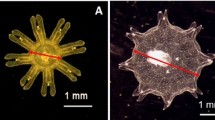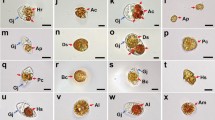Abstract
In situ grazing rates for the mixotrophic dinoflagellate Gymnodinium sanguineum Hirasaka feeding on nanociliate populations of Chesapeake Bay were determined in June and October of 1990 using a “gut clearance/gut fullness” approach. Recently ingested prey were digested beyond the point of recognition at a rate of ∼23% h-1. Estimates of in situ ingestion and clearance ranged from 0 to 0.06 prey dinoflagellate-1 h-1 and 0 to 5.8 μl dinoflagellate-1 h-1, respectively, with daily removal of ciliate biomass representing 6 to 67% of the ≤20-μm oligotrich standing stock. Daily consumption of ciliate biomass by G. sanguineum averaged 2.5% of body carbon and 4.0% of body nitrogen with maximal values of 11.6 and 18.5%, respectively. Ingestion of ciliates may help balance nitrogen requirements for G. sanguineum and give this species an advantage over purely photosynthetic dinoflagellates in nitrogen limited environments. By preying on ciliates, these dinoflagellates reverse the normal flow of material from primary producer to consumer and thereby influence trophodynamics of the microbial food web in Chesapeake Bay.
Similar content being viewed by others
Literature cited
Banse, K. (1982). Cell volumes, maximal growth rates of unicellular algae and ciliates, and the role of ciliates in the marine pelagial. Limnol. Oceanogr. 27: 1059–1071
Bennett, J. P., Woodward, J. W., Shultz, D. J. (1986). Effect of discharge on the chlorophyll α distribution in the tidally-influenced Potomac River. Estuaries 9: 250–260
Bennett, S. J., Sanders, R. W., Porter, K. G. (1990). Heterotrophic, autotrophic, and mixotrophic nanoflagellates: seasonal abundances and bacterivory in a eutrophic lake. Limnol. Oceanogr. 35: 1821–1832
Biecheler, B. (1952). Recherches sur les Peridiniens. Bull. biol. Fr. Belg. (Suppl.) 36: 1–149
Bird, D. F., Kalff, J. (1986). Bacterial grazing by planktonic lake algae. Science, N. Y. 231: 493–495
Bird, D. F., Kalff, J. (1987). Algal phagotrophy: regulating factors and importance relative to photosynthesis in Dinobryon (Chrysophyceae). Limnol. Oceanogr. 32: 277–284
Bird, D. F., Kalff, J. (1989). Phagotrophic sustenance of a metalimnetic phytoplankton peak. Limnol. Oceanogr. 34: 155–162
Bjørnsen, P. K., Kuparinen, J. (1991). Growth and herbivory by heterotrophic dinoflagellates in the Southern Ocean, studied by microcosm experiments. Mar. Biol. 109: 397–405
Bockstahler, K. R., Coats, D. W. (1993). Spatial and temporal aspects of mixotrophy in Chesapeake By dinoflagellates. J. eukaryotic Microbiol. 40: 49–60
Cachon, M., Cachon, J., Cosson, J., Greuet, C., Huitorel, P. (1991). Dinoflagellate flagella adopt various conformations in response to different needs. Biol. cell 71: 175–182
Capriulo, G. M., Degnan, C. (1991). Effect of food concentration on digestion and vacuole passage time in the heterotrichous ciliate Fabrea salina. Mar. Biol 110: 199–202
Caron, D. A., Porter, K. G., Sanders, R. W. (1990). Carbon, nitrogen, and phosphorus budgets for the mixotrophic phytoflagellate Proterioochromonas malhamensis (Chrysophyceae) during bacterial ingestion. Limnol. Oceanogr. 35: 433–443
Coats, D. W., Heinbokel, J. F. (1982). A study of reproduction and other life cycle phenomena in planktonic protists using an acridine orange fluorescence technique. Mar. Biol. 67: 71–79
Cullen, J. J., Horrigan, S. G. (1981). Effects of nitrate on the diurnal vertical migration, carbon to nitrogen ratio, and the photosynthetic capacity of the dinoflagellate Gymnodinium splendens. Mar. Biol. 62: 81–89
Dagg, M. J., Walser, E. W., Jr. (1987). Ingestion, gut passage, and egestion by the copepod Neocalanus plumchrus in the laboratory and in the subarctic Pacific Ocean. Limnol. Oceanogr. 32: 178–188
D'Elia, C. F., Sanders, J. G., Boynton, W. R., Jr. (1986). Nutrient enrichment studies in a coastal plain estuary: phytoplankton growth in large-scale, continuous culture. Can. J. Fish. aquat. Sciences 43: 397–406
Doddema, H., van der Veer, J. (1983). Ochromonas monicis sp. nov., a particle feeder with bacterial endosymbionts. Cryptogamie, Algologie 4: 89–97
Dodson, A. N., Thomas, W. H. (1964). Concentrating plankton in a gentle fashion. Limnol. Oceanogr. 9: 455–456
Dolan, J. R., Coats, D. W. (1991). Preliminary prey digestion in a predacious estuarine ciliate, Euplotes woodruffi, and the use of digestion data to estimate ingestion. Limnol. Oceanogr. 36: 558–565
Dortch, Q., Maske, H. (1982). Dark uptake of nitrate reductase activity of a red-tide population off Peru. Mar. Ecol. Prog. Ser. 9: 299–303
Doucette, G. J., Harrison, P. J. (1991). Aspects of iron and nitrogen nutrition in the red tide dinoflagellate Gymnodinium sanguineum. Mar. Biol. 110: 165–173
Estep, K. W., Davis, P. G., Keller, M. D., Sieburth, J. M. (1986). How important are oceanic algal nanoflagellates in bacterivory? Limnol. Oceanogr. 31: 646–650
Fenchel, T. (1975). The quantitative importance of benthic microfauna of an arctic tundra pond. Hydrobiologia 46: 445–464
Fenchel, T. (1987). Ecology of Protozoa, the biology of free-living phagotrophic protists. Springer-Verlag, Berlin
Fiedler, P. C. (1982). Zooplankton avoidance and reduced grazing responses to Gymnodinium splendens (Dinophyceae). Limnol. Oceanogr. 27: 961–965
Fisher, T. R., Peele, E. R., Ammerman, J. W., Harding, L. W., Jr. (1992). Nutrient limitation of phytoplankton in Chesapeake Bay. Mar. Ecol. Prog. Ser. 82: 51–63
Gallegos, C. L., Jordan, T. E., Correll, D. L. (1992). Event-scale response of phytoplankton to watershed inputs in a subestuary: timing, magnitude, and location of phytoplankton blooms. Limnol. Ocenaogr. 37: 813–828
Gaines, G. (1988). Feeding and reproduction of heterotrophic dinoflagellates. (Abstr). In: Burkill, P. H., Reid, P. C. (eds.) Protozoa and their role in marine processes. NATO Advanced Study Institute, Plymouth Marine Laboratory and Plymouth Polytechnic, Plymouth, p. 38–39
Gaines, G., Elbrächter, M. (1987). Heterotrophic nutrition. In: Taylor, F. J. R. (ed.) The biology of dinoflagellates. Blackwell Scientific Publishers, Oxford, p. 224–268
Goldman, J. C., Dennett, M. R., Gordin, H. (1989). Dynamics of herbivorous grazing by the heterotrophic dinoflagellate Oxyrrhis marina. J. Plankton Res. 11: 391–407
Goulder, R. (1972). Grazing by the ciliated protozoon Loxodes magnus on the alga Scenedesmus in a eutrophic pond. Oikos 23: 109–115
Hansen, P. J. (1991). Quantitative importance and trophic role of heterotrophic dinoflagellates in a coastal pelagial food web. Mar. Ecol. Prog. Ser. 73: 253–261
Hansen, P. J. (1992). Prey size selection, feeding rates and growth dynamics of heterotrophic dinoflagellates with special emphasis on Gyrodinium spirale. Mar. Biol. 114: 327–334
Harding, L. W., Jr., Meeson, B. W., Fisher, T. R., Jr. (1986). Phytoplankton production in two east coast estuaries: photosynthesis-light function and pattern of carbon assimilation in Chesapeake and Delaware Bays. Estuar. estl Shelf Sci. 234: 773–806
Harrison, W. G. (1976). Nitrate metabolism of the red tide dinoflagellate Gonyaulax polyedra Stein. J. exp. mar. Biol. Ecol. 21: 199–209
Heaney, S. I., Eppley, R. W. (1981). Light, temperature and nitrogen as interacting factors affecting diel vertical migrations of dinoflagellates in culture. J. Plankton Res. 3: 331–344
Jacobson, D. M. (1988). Growth and feeding rates of Protoperidinium. (Abstr). In: Burkill, P. H., Reid, P. C. (eds.) Protozoa and their role in marine processes. NATO Advanced Study Institute, Plymouth Marine Laboratory and Plymouth Polytechnic, Plymouth, p. 60
Jerome, C. A., Montagnes, D. J. S., Taylor, F. J. R. (1993). The effect of quantitative Protargol staining (QPS) and Lugol's and Bouin's fixatives on cell size: a more accurate estimate of ciliate species biomass. J. eukaryotic Microbiol. 40: (in press)
Kopylov, A. I., Tumantseva, N. I. (1987). Analysis of the contents of tintinnid food vacuoles and evaluation of their contribution to the consumption of phytoplankton production off the Peru coast. Oceanology 27: 343–347
Lessard, E. J., Swift, E. (1985). Species-specific grazing rates of heterotrophic dinoflagellates in oceanic waters, measured with a dual-label radioisotope technique. Mar. Biol. 87: 289–296
Lessard, E. J. (1991). The trophic role of heterotrophic dinoflagellates in diverse marine environments. Mar. microb. Fd Webs 5: 49–58
Loftus, M. E., Subba Rao, D. V., Seliger, H. H. (1972). Growth and dissipation of phytoplankton in Chesapeake Bay. 1. Response to a large pulse of rainfall. Chesapeake Sci. 13: 282–299
Malone, T. C., Crocker, L. H., Pike, S. E., Wendler, B. W. (1988). Influences of river flow on the dynamics of phytoplankton production in a partially stratified estuary. Mar. Ecol. Prog. Ser. 48: 235–249
Montagnes, D. J. S., Lynn, D. H. (1987). A quantitative Protargol stain (QPS) for ciliates: method description and test of its quantitative nature. Mar. microb. Fd Webs 2: 83–93
Öpik, H., Flynn, K. J. (1989). The digestive process of the dinoflagellate Oxyrrhis marina Dujardin, feeding on the chlorophyte, Dunaliella primolecta Butcher: a combined study of ultrastructure and free amino acids. New Phytol. 113: 143–151
Porter, K. G. (1988). Phagotrophic phytoflagellates in microbial food webs. Hydrobiologia 159: 89–97
Putt, M., Stoecker, D. K. (1989). An experimentally determined carbon:volume ratio for marine “oligotrichous” ciliates from estuarine and coastal waters. Limnol. Oceanogr. 34: 1097–1103
Sanders, R. W. (1991). Mixotrophic protists in marine and freshwater ecosystems. J. Protozool. 38: 76–81
Sanders, R. W., Porter, K. G. (1988). Phagotrophic phytoflagellates. Adv. microb. Ecol. 10: 167–192
Sanders, R. W., Porter, K. G., Bennett, S. J., DeBiase, A. E. (1989). Seasonal patterns of bacterivory by flagellates, ciliates, rotifers, and cladocerans in a freshwater plankton community. Limnol. Oceanogr. 34: 673–687
Sanders, R. W., Porter, K. G., Caron, D. A. (1990). Relationship between phototrophy and phagotrophy in the mixotrophic chrysophyte Proterioochromonas malhamensis. Microb. Ecol. 19: 97–109
Sellner, K. G., Lacouture, R. V., Cibik, S. J., Brindley, A., Brownlee, S. G. (1991). Importance of a winter dinoflagellate-microflagellate bloom in the Patuxent River Estuary. Estuar. cstl Shelf. Sci. 32: 27–42
Sellner, K. G., Brownlee, D. C. (1990). Dinoflagellate-microzooplankton interactions in Chesapeake Bay. In: Graneli, E., Sondstrom, B., Edler, L., Anderson, D. M. (eds.) Toxic marine phytoplankton. Elsevier, New York, p. 221–226
Sellner, K. G., Kachur, M. E. (1987). Phytoplankton: relationships between phytoplankton, nutrients, oxygen flux and secondary producers. In: Heck, K. L., Jr. (ed.) Ecological studies in the middle reach of Chesapeake Bay: Calvert Cliffs. Springer-Verlag, Berlin, p. 11–37
Sellner, K. G., Olson, M. M. (1985). Copepod grazing in red tides of Chesapeake Bay. In: Anderson, A. M., White, A. W., Baden, D. G. (eds.) Toxic dinoflagellates. Elsevier Sci. Pub. Co., Inc., New York, p. 245–250
Sokal, R. R., Rohlf, F. J. (1981). Biometry, 2nd edn. W. H. Freeman & Co., New York
Stoecker, D. K., Silver, M. W., Michaels, A. E., Davis, L. H. (1988). Obligate mixotrophy in Laboea strobila, a ciliate which retains chloroplasts. Mar. Biol. 99: 415–423
Strom, S. L. (1991). Growth and grazing rates of the herbivorous dinoflagellate Gymnodinium sp. from the open subarctic Pacific Ocean. Mar. Ecol. Prog. Ser. 78: 103–113
Thomas, W. H., Dodson, A. N. (1974). Effects of interactions between temperature and nitrate supply on the cell-division rates of two marine phytoflagellates. Mar. Biol. 24: 213–217
Throndson, J. (1978). Preservation and storage. In: Sournia, A. (ed.) Phytoplankton manual. UNESCO, Paris, p. 69–74
Verity, P. G., Stoecker, D. K., Sieracki, M. E., Burkill, P. H., Edwards, A. S., Tronzo, C. R. (1993). Abundance, biomass, and distribution of heterotrophic dinoflagellates during the North Atlantic spring bloom. Deep-Sea Res. 40: 227–244
Wang, R., Conover, J. R. (1986). Dynamics of gut pigment in the copepod Temora longicornis and the determination of in situ grazing rates. Limnol. Oceanogr. 31: 867–877
Author information
Authors and Affiliations
Additional information
Communicated by J.P. Grassle, New Brunswick
Rights and permissions
About this article
Cite this article
Bockstahler, K.R., Coats, D.W. Grazing of the mixotrophic dinoflagellate Gymnodinium sanguineum on ciliate populations of Chesapeake Bay. Marine Biology 116, 477–487 (1993). https://doi.org/10.1007/BF00350065
Received:
Accepted:
Issue Date:
DOI: https://doi.org/10.1007/BF00350065




